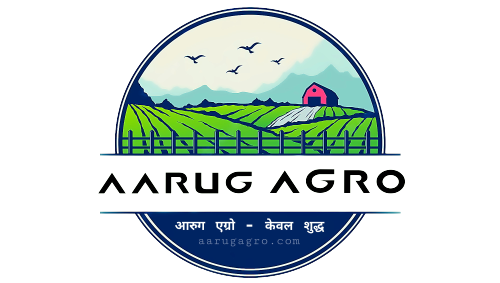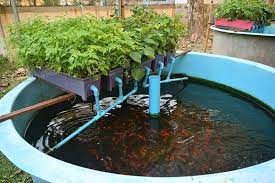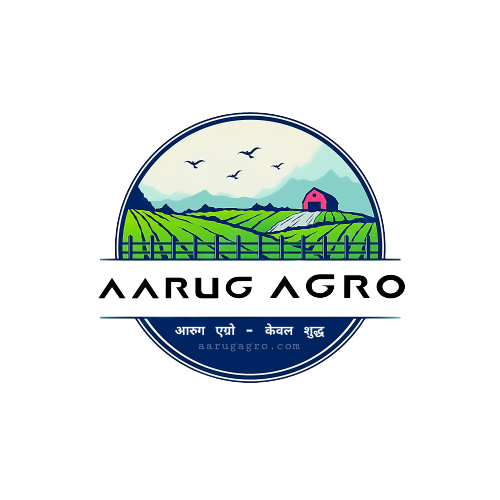Introduction of Aquaponics Design: Today, let us discuss about Aquaponics Design, Advantages, Disadvantages, types and components of system. Aquaponics is a combined of aquaculture, which is growing fish and other aquatic animals, and hydroponics which is growing plants without soil. Aquaponics uses these two in a symbiotic arrangement in which plants are fed the aquatic animals’ waste. In return, the vegetables fresh the water that goes back to the fish. Along with the fish and their waste, microbes play a key role in the nutrition of the plants. This beneficial bacterium gathers in the spaces between the roots of the plant and converts the fish waste and the solids into substances the plants can use to grow. The result is a great collaboration between aquaculture and gardening.
The fish waste provides organic food for the rising plants and the plants naturally filter the water in which the fish live. The beneficial bacteria exist on each moist surface of an Aquaponic system. They convert the ammonia from the fish waste that is toxic to the fish and hopeless to the plants, first into nitrites and then into nitrates. The nitrates are moderately harmless to the fish and most importantly, they make terrific plant food. The worms change the solid waste and decaying plant matter in your Aquaponic system into vermicompost.
The benefits of Aquaponics
A sustainable production system was measured using aquaponics. It displays a number of useful environmental characteristics. The following are some advantages:
- environmentally friendly, using less water and electricity.
- Fish food and water are the system’s two main inputs.
- No use of chemicals. Aquaponics uses minimal pesticides and no synthetic fertilizers.
- Numerous easily grown plants can flourish in aquaponic systems.
- very little vulnerability to illnesses and pests.
- increased crop production on a per-square-foot basis compared to conventional farming.
- The same technology can be used to produce various crops and fish.
- Fish can be caught to provide additional food and income.
Aquaponics design
How Aquaponics Works
A sustained, self-sufficient ecosystem that can be harvested like a farm is created by successfully combining the techniques of aquaculture and hydroponics. An aquaculture subsystem, a hydroponics subsystem, and the addition of bacteria must first be made in order to form an aquaponics system.
Water from a fish tank is circulated through a vegetable grow bed in an aquaponics system. Fish waste provides the plants with nutrients, and the plants filter the water to keep the fish healthy. The fish tank and the grow beds are the two main parts of the system, and a little pump transports water between them.
Components of an Aquaponics Farm
There are many components of an Aquaponics farm. In aquaculture tanks, waste formed by the fish in the tank will sink to the bottom and, unless removed, become toxic in larger concentrations. This waste, however, contains many nutrients that support plant growth. So, plants are added to the bottom of the tank, consuming the waste from the fish and producing food that the fish can later eat. The end result is a productive cross between aquaculture and hydroponics — Aquaponics. The mechanism of a typical subsistence Aquaponics system includes:
Rearing Tank: Raised fish are fed into the tank.
Settling Basin: a device that removes tiny particles and captures unfinished food and biofilms that have broken off.
Biofilter: A location where bacteria can convert trash and ammonia to other nitrates that plants can use as nourishment.
Hydroponics Subsystem: a part of the system where overabundant nutrients in the water are used to grow plants.
Sump: The lowest place in the hierarchy. When water reaches this sump point, it is pumped back into the system.
Types of Aquaponics Systems
These are the four elements that every Aquaponics system has in common:
- Fish tank or aquarium.
- Plant-growing area.
- A technique (water pumps are frequently employed) for moving water from the fish tank to the grow bed.
- A technique (typically siphons or pipelines) for returning water from the fish tank to the grow bed.
Choose a Media-Based Design
In aquaponics, there are three basic types of systems utilized to cultivate plants. DWC (deep-water culture), NFT (nutrient film technique), and media-based systems are the three different types. The first two systems are a little more expensive and sophisticated and are based on hydroponics.
It is highly advised that you select a media-based Aquaponics system design if you are new to the practice. Several factors contribute to this:
- The procedure is much simpler to understand and recognize.
- It costs less because there are fewer parts needed.
- The three filtering processes—mechanical (which removes solids), mineralization (which breaks down materials and returns them to the water), and biological filtration—are all carried out by a media bed.
- Because a media bed is also used as the foundation for growing plants, it serves as a multipurpose purpose.
- Media more closely resembles traditional soil gardening, giving plants better support.
Read More: Borewell Drilling Cost, Pump Price, and Pipe Cost
Use a Basic Flood & Drain Design:
The flood and drain design is the most straightforward and popular among media-based aquaponics system layouts for home aquaponic gardeners.
The following are the main advantages of this system:
- It is simple to put together and comprehend.
- It does not require a lot of room in your house.
- Additionally, it is best suited for a growth bed to fish tank capacity ratio of 1:1.
- has considerable flexibility and is simple to customize.
- very simple to maintain.
Make sure that the grow bed is correct
The space where you grow your plants is one of the most crucial aspects of an Aquaponics system design, thus you need to understand how to pick the best Aquaponics grow bed.
It is not as simple as purchasing a sizable plastic container, stuffing it full with produce medium, and then putting your seeds inside. Make sure the material does not damage anything in the system, the size is suitable for plant development, and it is robust enough to bear the downward force of the medium, plants, and water flow.
Choose your ideal location for Aquaponics Design:
Your climate and available area will determine where you should put your aquaponics system. It would be acceptable to base your Aquaponics system in your backyard if you lived somewhere with good weather for the majority of the year, but there are a number of other choices as well:
- Harvest your vegetables and fish during the appropriate times, then turn off the system when winter or summer arrives until the appropriate time again.
- Relocate your aquaponics system inside if it needs to shut down during particular seasons.
- Install your aquaponics system indoors and keep it there.
- Build a greenhouse and set a shop inside.
In your aquaponics system, a 1,000 liter (264 US Gallons) tank will support 50 to 80 fish. If the grow beds are roughly 300 millimeters (12 inches) deep, that will sustain 1,200 liters (317 US Gallons) to 1,800 liters (475 US Gallons) of growth beds.
A system containing two 600-liter grow beds and one 1,000-liter tank will need at least 18 meters square (200 square feet) of space. A 3 m x 6 m (10 ft x 20 ft) is what that is. With a growing space of 4 square meters (44 square feet), it might support, say, 50 fish.
Aquaponics disadvantages
- The aquaponics system also has some drawbacks.
- High initial investment expenses for the technology and apparatus used in aquaponic systems
- There are several areas in aquaponics systems where problems could cause the entire system to collapse (and fish to die).
- An aquaponics system uses more power than standard farming and crop systems, but this is to be expected because fish tanks need to be heated. Although an aquaponics system may be more expensive than growing crops, it has the added benefits of fresh fish and significantly less waste.
- More Research Required—Of course, maintaining an Aquaponics system will require research, but learning how to cultivate crops or raise fish will also require more research.


